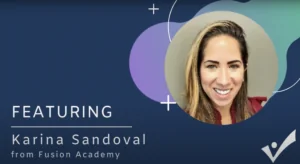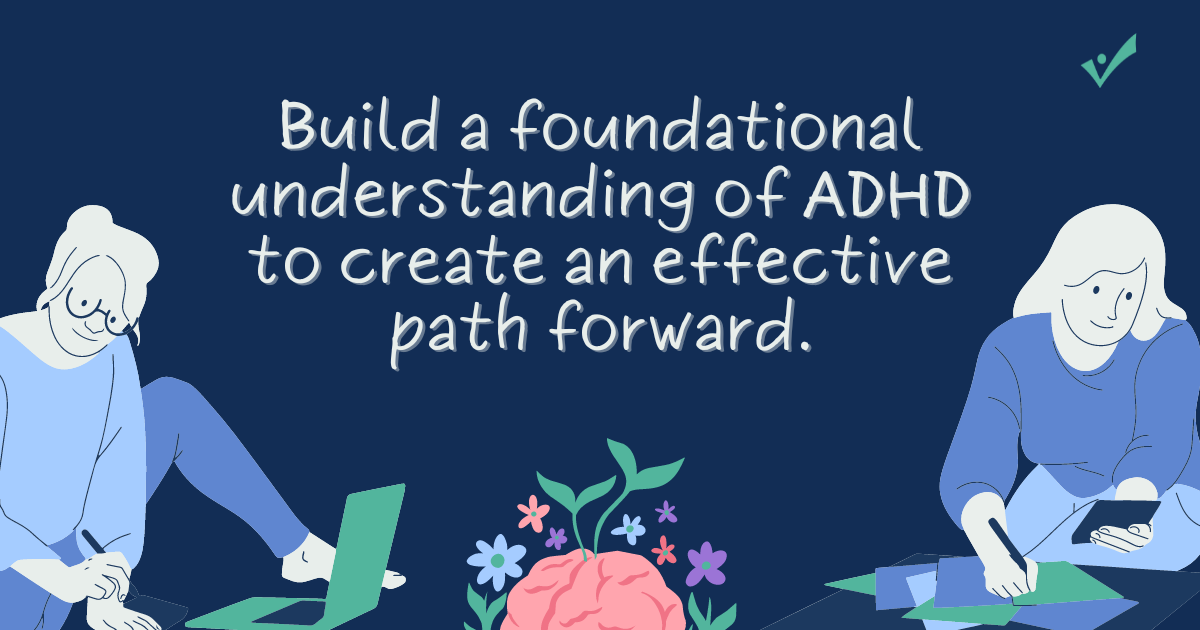Navigating ADHD as a Parent
- thrivister
- August 24, 2023
When you watch your student struggling with executive functioning at school and in their everyday lives, it can feel overwhelming and discouraging for both of you. The first step towards helping your teen or young adult thrive is equipping yourself with knowledge. It can be difficult to strategize a plan for improvement when there isn’t a foundational understanding of ADHD. So the team at Thrivister decided to create a comprehensive ADHD guide for parents with kids who have ADHD.
We’ll cover the types, the research, the symptoms, and finally the hope! ADHD can be managed and even harnessed for greatness when the right support is put in place. Let’s dive into the facts of ADHD so you can carve a path forward with your student.
Defining ADHD
Attention Deficit Hyperactivity Disorder (ADHD) is a neurodevelopmental syndrome that impacts the brain’s ability to regulate executive functioning skills (EFS), which include attention, working memory, motivation, impulse control, organization, motivation, and social interaction.2
There are three main presentation types of ADHD:15
- Hyperactive-impulsive
- Inattentive
- Combined
Attention Deficit Hyperactivity Disorder, no matter the presentation type, has a heavy impact on your student’s daily life, from activities to relationships. And they’re not alone—6 million children aged 3-17 have been diagnosed with ADHD, 3.3 million (13%) of whom are adolescents.14 A 2021 study found that almost 366 million (~7%) of adults around the world struggle with ADHD.11
Thankfully, there are many avenues you can take to support your student through their treatment journey. But first, let’s dive into how ADHD can show up in their life.
Signs & Symptoms
You’ve probably witnessed ADHD manifesting in your student’s life: misplacing their phone, shaking their leg or tapping their fingers, overlooking details of assignments, hyper-focusing on their favorite activities, or becoming easily distracted.
The Diagnostic and Statistical Manual of Mental Health (DSM-5-TR) is used by all mental health professionals to assist in the diagnosis and treatment of ADHD. Let’s break down each ADHD type and how each one manifests:13
Hyperactive & Impulsive Presentation Symptoms13
- Fidgets or squirms in their seat
- Leaves their seat when they’re not supposed to
- Restless, or runs/climbs when considered inappropriate
- Trouble being quiet when engaging in their favorite activities
- Lots of energy (always on the go or seemingly hard to keep up with)
- Talking excessively
- Blurts out an answer before a question is fully stated
- Trouble waiting for their turn
- Interrupts others, or intrudes on others’ activities
Inattentive Presentation Symptoms13
- Lacks attention to detail or makes careless mistakes
- Difficulty keeping focus
- Often caught daydreaming
- Trouble following through on commitments
- Difficulty organizing tasks
- Avoids engaging in tasks that require a lot of concentration
- Frequently misplacing things
- Easily distracted
- Forgets about doing chores or other daily activities
Common, Lesser-Known Symptoms
At Thrivister, we find that most students with ADHD commonly face these lesser-known symptoms, regardless of the presentation type they exhibit.
- Time blindness
- Hyperfocus
- Disorganization
- Trouble regulating emotions (commonly referred to as emotional regulation)
- Easily distracted
- Trouble falling and/or staying asleep
- Easily loses interest
- Difficulty making decisions
- Difficulty getting motivated
The combined presentation type exhibits symptoms of both hyperactive-impulsive and inattentive presentations.15
Because everyone diagnosed with ADHD has a unique experience, we recommend writing down the symptoms you’ve seen them exhibit. This information will help you talk with your doctor and develop the right treatment plan for your student.
Diagnosis
Taking your student for an ADHD diagnosis evaluation is an excellent step in getting them the support they need. While mental health professionals use the DSM-5-TR to help the ADHD diagnosis process, there is not one specific diagnostic test for ADHD. So, diagnosis relies on assessments by your doctor and reports by you and your student.
Here’s what a diagnostic evaluation might look like…6
- A medical, physical, and neurological exam to rule out any medical conditions
- A full medical history is taken from both you and your teen, especially if there’s a family history of ADHD
- A review of previous educational records
- Additional screenings may be performed based on your young adult’s symptoms (such as IQ, educational achievement, learning disability, vision, hearing, speech, and language)
Your doctor will then determine if your student has ADHD, its presentation type, and its severity. We do want to note that oftentimes, family physicians don’t have the same breadth of expertise about ADHD as their specialized counterparts. They may refer you to a specialist so your student can receive a more comprehensive evaluation.
If your student exhibits symptoms of ADHD but doesn’t meet the full criteria for one of the three main types of ADHD, they may be diagnosed with Other Specified ADHD.3 Receiving an “Other Specified” diagnosis doesn’t mean that their experience is invalid or less (or more) severe than specific diagnoses. It simply means that your teenager or young adult didn’t meet the full criteria set by the DSM-V-TR. And that’s okay!
Once the evaluation is complete, your doctor will work closely with you and your student to develop a treatment plan to create an effective path forward.
An ADHD Diagnosis Defines the Journey, Not the Person
Here at Thrivister, we believe diagnoses are simply a recognition of your student’s experience that can be used to protect and support them. Receiving a diagnosis may feel overwhelming, discouraging, or even shameful for your student. And as a parent, it can be a bit scary. All of those emotions and worries you may be experiencing are absolutely valid, but rest assured, there’s a beacon of hope ahead.
Receiving a diagnosis is only a single step in your student’s journey to a successful, empowered life. They are still capable of greatness—having ADHD doesn’t change that. It just means they need a different kind of support than their peers to realize that potential.
The students we’ve worked with have often found that once they are able to manage their ADHD symptoms, they can find ways to use them to their advantage. For example, your college student could use their hyperfocus to pursue their passion for photography and create a secondary income stream. Or your high school student’s nonlinear thinking could provide a fresh perspective in the classroom and aid in generating ideas for group projects.
An ADHD diagnosis is not a label or pre-determined destiny: it’s a roadmap to guide your student’s success.
Causes
Now that you know a bit more about ADHD, you may be wondering what causes ADHD in the first place. The World Federation of ADHD Guide gives a comprehensive, science-backed chronicle of the different causes of ADHD. Here’s a snapshot!
- ADHD is a highly genetic condition. Many twin studies have shown that nearly one in four children with ADHD is likely to have a relative with ADHD.10
- At the core of ADHD is a chemical imbalance of neurotransmitters (e.g. dopamine, norepinephrine, serotonin, histamine) that regulate hyperactivity, impulsivity, and inattentiveness in the brain. While we’re not medical professionals, we can say that this chemical imbalance is why ADHD medication is a commonly prescribed treatment. These medications are designed to regulate these chemicals in response to your student’s symptoms.10
- Environmental factors can contribute to the development of ADHD at birth and throughout your student’s developmental years.10
- Some environmental factors have been proven NOT to increase the risk of ADHD: sugar consumption, mercury in vaccines, sleep restriction, C-section birthing, and solar intensity.10
Bottom Line: ADHD is due to multiple factors, including but not limited to, genes, environment, and chemical imbalance in the brain.
Treatment & Symptom Management
There are many treatment options for ADHD, and it can be hard to sift through the noise. While we are not doctors, we can provide some insight into treatment options available to your student that you can further explore. Through years of experience working with students with ADHD, we’ve found that students who have a combination of support types often have higher success rates in school.
Treatment is most effective when using a tailored, long-term combination of behavioral, medical, and educational interventions.7
Behavior
- Start with self-education. ADHD affects everyone differently, so knowing how ADHD directly impacts your student will be a powerful asset throughout their treatment journey. Check out our ADHD Academic Success Course, built for parents who want to learn skills for understanding and supporting their children with ADHD or weak EFS.
- Behavioral parent training is a therapy method where a therapist will teach you and your student about techniques to manage and improve your student’s behavior.8
Medical
- Medication. The two main types of medicines used to improve symptoms of ADHD and improve quality of life are psychostimulants and non-stimulants. According to CHADD, over 70% of children with ADHD respond well to medication treatment.7 Adding medication to your student’s treatment plan is a big decision, so take your time in considering the pros and cons based on your student’s individual needs.
- Alternative treatments. It’s important to note that the following alternative treatment options aren’t scientifically proven to help with ADHD, but still may be helpful to explore if other options have been ineffective.7 Always consult with your doctor before trying an alternative form of treatment.
- Dietary Changes & Supplements
- Interactive Metronome Training
- Sensory Integration Training
- EEG Biofeedback
Book an appointment with your doctor to discuss a comprehensive treatment plan to help support your student’s success and manage their ADHD or weak EFS symptoms for the long term.
Support in School
- Know your rights. Learn about the Individuals with Disabilities Education Act (IDEA) and Section 504 of the Rehabilitation Act, which are federal laws put into place to protect your student in school, and beyond.
- Utilize existing supports. Learn about the schools pre-existing support pillars that are available to your student. We commonly see resources like school resource teachers, psychologists, social workers, and counselors.
- Request an academic evaluation. Whether your student is in high school or college, you can request an evaluation in writing to review your student’s specific needs and how they can be met.
- Advocate for a customized, law-backed plan. Explore working with your school to develop an Individualized Education Program (IEP) or a 504 Accommodation Plan to provide your student with added support and services to ensure their academic success.
- Consider investing in a Thrivister academic coach for added support. Studies have shown that coaching is an effective way to boost confidence, improve GPAs and college retention rates, and create a lasting impact on EFS skills.1 We have created an unparalleled framework here at Thrivister that has enabled our coaches to bring hundreds of students from the depths of overwhelm to brand-new heights of success.
- Create a transition plan for your student’s future. Have a conversation with your student about what they want to do after graduation. Do they want to continue their formal education, learn a trade, enter the workforce, or take some time to volunteer or travel? Do they want to stay at home or move out? This conversation will be helpful in reducing anxiety about their future, as well as encourage conversation about EFs and life skills they might need to meet those goals. A Thrivister coach can help a lot here too!
As you’ve learned, there are multiple modalities available to help support your student with ADHD. Many times, the most effective approach is a multipronged strategy. There is no one-size-fits-all solution, as every student is unique. Customization of their treatment plan, along with a bit of testing, can lead to highly successful outcomes over time.
Conclusion
ADHD is a complex neurological condition that impacts every aspect of your student’s life.
We understand that being the parent of a student with ADHD can be frustrating and discouraging sometimes. Watching them struggle to excel in school and life can feel like a stressful, compounded by the friction and resistance that can arise when offering guidance. But don’t lose hope: you’ve equipped yourself with the tools you need to craft a roadmap for a brighter future and if you need help there are resources available.
Understanding what your student is going through is essential to helping them successfully navigate through life. As Kofi Annan, former Secretary-General of the United Nations once said, “Knowledge is power. Information is liberating. Education is the premise of progress, in every society, in every family.” With this philosophy in mind, we are confident that this newly-acquired knowledge will enable you to more deeply understand your students thought processes and frustrations.
We hope that this guide serves as a great starting point for growing your ADHD toolbox.
If you would like to learn more about ADHD and the role you can play in your child’s success, check out our ADHD Academic Success Course.
Found this helpful? Spread the knowledge.
References
- Ahmann, E., Tuttle, L. J., Saviet, M., & Wright, S. D. (2018). A Descriptive Review of ADHD Coaching Research: Implications for College Students. Journal of Postsecondary Education and Disability, 31(1). https://files.eric.ed.gov/fulltext/EJ1182373.pdf
- Buitelaar, J. K., can der Meer, D., & Richards, J. (2019). Understanding the Essentials of the ADHD Neurobiology. In The World Federation of ADHD Guide (pp. 17-41). The World Federation of ADHD. https://www.adhd-federation.org/_Resources/Persistent/6d9ca34c09972aea00d0ea6d02be6f6d6bd5bb4c/The%20WF%20ADHD%20Guide_072019.pdf
- Child Mind Institute. (2022, May 19). What Is an “Other Specified” Diagnosis? Child Mind Institute. Retrieved August 22, 2023, from https://childmind.org/article/what-is-an-other-specified-diagnosis/
- Children and Adults with Attention-Deficit/Hyperactivity Disorder (CHADD). (n.d.). About ADHD – Symptoms, Causes and Treatment. CHADD. Retrieved August 22, 2023, from https://chadd.org/about-adhd/overview/
- Children and Adults with Attention-Deficit/Hyperactivity Disorder (CHADD). (n.d.). Complementary Treatment. CHADD. Retrieved August 22, 2023, from https://chadd.org/about-adhd/complementary-and-other-interventions/
- Children and Adults with Attention-Deficit/Hyperactivity Disorder (CHADD). (n.d.). Evaluating for Childhood ADHD. CHADD. Retrieved August 22, 2023, from https://chadd.org/for-parents/evaluating-for-childhood-adhd_qf/
- Children and Adults with Attention-Deficit/Hyperactivity Disorder (CHADD). (n.d.). Managing Medication. CHADD. Retrieved August 22, 2023, from https://chadd.org/for-parents/managing-medication/
- Children and Adults with Attention-Deficit/Hyperactivity Disorder (CHADD). (n.d.). Parent Training and Education. CHADD. Retrieved August 22, 2023, from https://chadd.org/for-parents/parent-training-and-education/
- Children and Adults with Attention-Deficit/Hyperactivity Disorder (CHADD). (n.d.). Requesting an Evaluation in Public Schools. CHADD. Retrieved August 22, 2023, from https://chadd.org/for-parents/requesting-an-evaluation-in-public-schools/
- Faraone, S. V., Palacios Cruz, L., & de la Peña, F. R. (2019). Understanding the Essentials of the Etiology of ADHD. In The World Federation of ADHD Guide (pp. 1-16). The World Federation of ADHD. https://www.adhd-federation.org/_Resources/Persistent/6d9ca34c09972aea00d0ea6d02be6f6d6bd5bb4c/The%20WF%20ADHD%20Guide_072019.pdf
- Song, P., Mingming Zha, Yang, Q., & Li, X. (2021). The prevalence of adult attentiondeficit hyperactivity disorder: A global systematic review and meta-analysis. Journal of Global Health, 11(04009), 9. 10.7189
- Smith, L., & Johnston, B. (2022, October 11). 10 Signs and Symptoms of ADHD in Adults (And When to Get Help) – ADDA. Attention Deficit Disorder Association. Retrieved August 22, 2023, from https://add.org/signs-of-adhd/
- Substance Abuse and Mental Health Services Administration. (2016, June). Table 7, DSM-IV to DSM-5 Attention-Deficit/Hyperactivity Disorder Comparison – DSM-5 Changes. NCBI. Retrieved August 22, 2023, from https://www.ncbi.nlm.nih.gov/books/NBK519712/table/ch3.t3/
- Walensky, R. P., Houry, D., Jernigan, D. B., Bunnel, R., Layden, J., Dauphin, L., & Centers for Disease Control and Prevention. (2022, February 25). Mental Health Surveillance Among Children — United States, 2013–2019. Morbidity and Mortality Weekly Report (MMWR), 71(2). https://www.cdc.gov/mmwr/volumes/71/su/pdfs/su7102a1-H.pdf
- Williams, P., & Dodson, M.D, LF-APA, W. (2019, September 1). 3 Types of ADHD: Hyperactive, Inattentive, and Combined. ADDitude. Retrieved August 22, 2023, from https://www.additudemag.com/3-types-of-adhd/?src=test

M.Ed., BCC, CSS and Co-founder of Thrivister
As co-founder of Thrivister, my purpose and passion is to help young adults with executive function challenges to thrive: manage, organize and be successful in their academics, careers and life. My successful EFS Coaching Method and journey as an ADHD coach, career service specialist, author, blogger, podcaster and board-certified coach for over a decade, has laid the foundation for our platform.
We believe opportunities are plentiful for someone with executive function challenges when they have the support and resources behind them. It is our mission through Thrivister to help as many people as possible be successful academically and into their future careers and life.

7 Trailblazing Celebrities and Icons Living & Thriving with ADHD
Explore the inspiring journeys of 7 influential individuals who have harnessed their ADHD to achieve greatness and make a lasting impact.

Unveiling the Complexities of ADHD: Insights from Dr. David Pomeroy
Unveiling the Complexities of ADHD: Insights from Dr. David Pomeroy https://youtu.be/EotABukIxloAttention Deficit Hyperactivity Disorder (ADHD) is a multifaceted condition that impacts millions of lives worldwide.

Navigating ADHD in Teens: Insights from MFT, Kelsey Thompson
Navigating ADHD in Teens: Insights from MFT, Kelsey Thompson https://youtu.be/omQndscdD5U In a recent interview with Kelsey Thompson, a seasoned Marriage and Family Therapist at The

Unlocking Potential: A Glimpse into Fusion Academy’s Personalized Education Model
Unlocking Potential: A Glimpse into Fusion Academy’s Personalized Education Model https://youtu.be/R7BgYW6A6k4 In the bustling world of education, where traditional models often struggle to meet the

